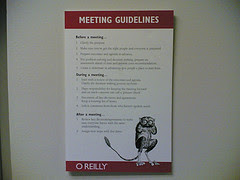 ONE OF THE CONTRIBUTING FACTORS TO MY decision to leave full-time nonprofit organizational life was the amount of time I spent in meetings. Board meetings, staff meetings, committee meetings, community meetings....you name it (and you know it, I'm sure). A day at the office wasn't complete without one....or two....or....
ONE OF THE CONTRIBUTING FACTORS TO MY decision to leave full-time nonprofit organizational life was the amount of time I spent in meetings. Board meetings, staff meetings, committee meetings, community meetings....you name it (and you know it, I'm sure). A day at the office wasn't complete without one....or two....or....Trying to contain meeting virus is a serious management tool. With so much written about it, it’s a wonder that many organizations still haven’t been able to master it very well or at all. Here’s one more bit of advice – by Harvard Business blogger Gina Trapini, Extreme Ways to Shorten and Reduce Meetings. Among her suggestions:
- Start and end on time. Basic stuff, but it’s amazing how many meetings don’t start on time. And when they don't start on time, they almost always run over. Have you noticed that by the end of these late-starters there are but a handful of people? What's the point of that?
- Meet standing up – a surefire way to keep meeting time to a minimum.
- Post a countdown clock so everyone can see the time…and the time left to get through the agenda.
- Keep agendas short. Ah, yes...that means weeding out all those reports of past events and putting the most critical stuff at the beginning of the meeting.
I like the idea of posting written meeting expectations in offices and meeting spaces (as in the photo above), and including it in board member and committee chair orientation packets. I think it's a great idea to go over meeting expectations with boards, staffs and committees, too. As your groups master the expectations, you may be able to raise the bar of expectations.
For those of you who are interested in what the rules say in the photo:
Before a meeting...
1. Clarify the purpose
2. Make sure you've got the right people and everyone is prepared
3. Prepare outcomes and agenda in advance
4. For problem-solving and decision-making prepare an assessment ahead of time and present your recommendation
5. Create a "strawman" in advance to give people a place to start from
During a meeting...
1. Start with a review of the outcomes and agenda
Clarify the decision-making process upfront
2. Share responsibility for keeping the meeting focused and on track -- anyone can call a "process check"
3. Document all key decisions and agreements
Keep a running list of issues
4. Solicit comments from those who haven't spoken much
After a meeting (or at the end of the meeting)....
1. Review key decisions/agreements to make sure everyone leaves with the same understanding
2. Assign next steps with due dates
Photo: Conference room wall from ginatrapani


Comments